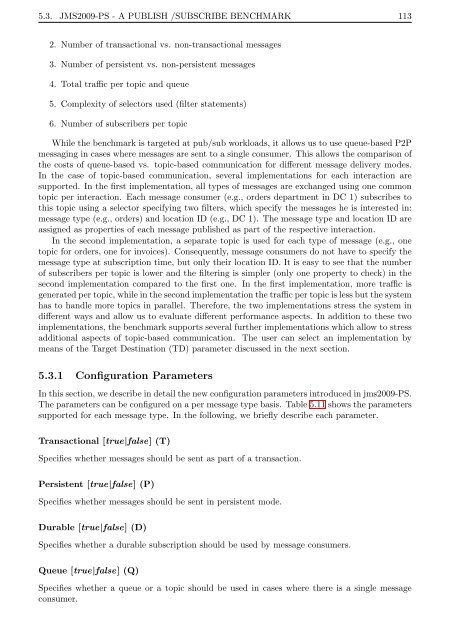Performance Modeling and Benchmarking of Event-Based ... - DVS
Performance Modeling and Benchmarking of Event-Based ... - DVS
Performance Modeling and Benchmarking of Event-Based ... - DVS
You also want an ePaper? Increase the reach of your titles
YUMPU automatically turns print PDFs into web optimized ePapers that Google loves.
5.3. JMS2009-PS - A PUBLISH /SUBSCRIBE BENCHMARK 113<br />
2. Number <strong>of</strong> transactional vs. non-transactional messages<br />
3. Number <strong>of</strong> persistent vs. non-persistent messages<br />
4. Total traffic per topic <strong>and</strong> queue<br />
5. Complexity <strong>of</strong> selectors used (filter statements)<br />
6. Number <strong>of</strong> subscribers per topic<br />
While the benchmark is targeted at pub/sub workloads, it allows us to use queue-based P2P<br />
messaging in cases where messages are sent to a single consumer. This allows the comparison <strong>of</strong><br />
the costs <strong>of</strong> queue-based vs. topic-based communication for different message delivery modes.<br />
In the case <strong>of</strong> topic-based communication, several implementations for each interaction are<br />
supported. In the first implementation, all types <strong>of</strong> messages are exchanged using one common<br />
topic per interaction. Each message consumer (e.g., orders department in DC 1) subscribes to<br />
this topic using a selector specifying two filters, which specify the messages he is interested in:<br />
message type (e.g., orders) <strong>and</strong> location ID (e.g., DC 1). The message type <strong>and</strong> location ID are<br />
assigned as properties <strong>of</strong> each message published as part <strong>of</strong> the respective interaction.<br />
In the second implementation, a separate topic is used for each type <strong>of</strong> message (e.g., one<br />
topic for orders, one for invoices). Consequently, message consumers do not have to specify the<br />
message type at subscription time, but only their location ID. It is easy to see that the number<br />
<strong>of</strong> subscribers per topic is lower <strong>and</strong> the filtering is simpler (only one property to check) in the<br />
second implementation compared to the first one. In the first implementation, more traffic is<br />
generated per topic, while in the second implementation the traffic per topic is less but the system<br />
has to h<strong>and</strong>le more topics in parallel. Therefore, the two implementations stress the system in<br />
different ways <strong>and</strong> allow us to evaluate different performance aspects. In addition to these two<br />
implementations, the benchmark supports several further implementations which allow to stress<br />
additional aspects <strong>of</strong> topic-based communication. The user can select an implementation by<br />
means <strong>of</strong> the Target Destination (TD) parameter discussed in the next section.<br />
5.3.1 Configuration Parameters<br />
In this section, we describe in detail the new configuration parameters introduced in jms2009-PS.<br />
The parameters can be configured on a per message type basis. Table 5.11 shows the parameters<br />
supported for each message type. In the following, we briefly describe each parameter.<br />
Transactional [true|false] (T)<br />
Specifies whether messages should be sent as part <strong>of</strong> a transaction.<br />
Persistent [true|false] (P)<br />
Specifies whether messages should be sent in persistent mode.<br />
Durable [true|false] (D)<br />
Specifies whether a durable subscription should be used by message consumers.<br />
Queue [true|false] (Q)<br />
Specifies whether a queue or a topic should be used in cases where there is a single message<br />
consumer.















